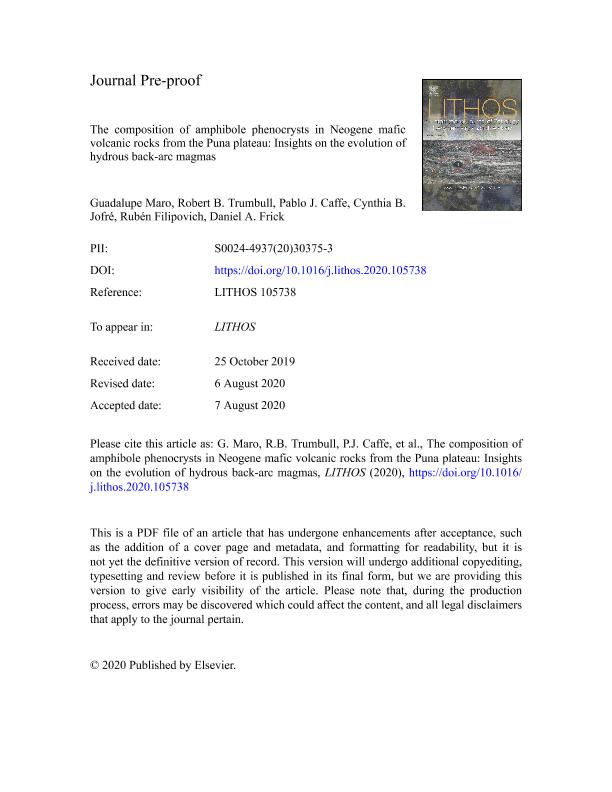Artículo
The composition of amphibole phenocrysts in Neogene mafic volcanic rocks from the Puna plateau: Insights on the evolution of hydrous back-arc magmas
Maro, Guadalupe ; Trumbull, Robert; Caffe, Pablo Jorge
; Trumbull, Robert; Caffe, Pablo Jorge ; Jofré, Cynthia Betina
; Jofré, Cynthia Betina ; Filipovich, Ruben Eduardo
; Filipovich, Ruben Eduardo ; Frick, Daniel A.
; Frick, Daniel A.
 ; Trumbull, Robert; Caffe, Pablo Jorge
; Trumbull, Robert; Caffe, Pablo Jorge ; Jofré, Cynthia Betina
; Jofré, Cynthia Betina ; Filipovich, Ruben Eduardo
; Filipovich, Ruben Eduardo ; Frick, Daniel A.
; Frick, Daniel A.
Fecha de publicación:
01/12/2020
Editorial:
Elsevier Science
Revista:
Lithos
ISSN:
0024-4937
Idioma:
Inglés
Tipo de recurso:
Artículo publicado
Clasificación temática:
Resumen
In typical Andean arc magmas, amphibole appears as a phenocryst phase only after considerable differentiation. However, some near-primitive volcanic rocks (high-Mg andesites and basalts) from monogenetic centers in the Puna plateau of Argentina also contain amphibole phenocrysts, implying special conditions of hydrous magma generation in this back-arc setting. This study documents typical examples from Southern and Northern Puna regions and uses the major and trace-element compositions of amphibole to constrain a petrogenetic model for the hydrous magmas. There are significant differences in the nature of amphiboles and their host lavas depending on location of the volcanic centers in the Southern and the Northern Puna regions. In the Southern Puna, basaltic andesitic lavas have Sr/Y values >40 and amphiboles show skeletal forms and occur in an assemblage with olivine and pyroxene. The amphibole compositions are relatively Al- and Ti-poor compared to the Northern Puna. Thermobarometry indicates amphibole crystallization temperatures of 960–1000 °C at moderate pressure (< 5 kbar). In contrast, the mafic lavas from centers in the Northern Puna show Sr/Y ratios lower than 20 and amphiboles in these rocks coexist with a plagioclase-orthopyroxene assemblage. The Northern Puna amphiboles have higher Ti and Al contents than those in the southern region and the thermobarometry estimates imply generally higher crystallization temperatures (>1000 °C) and pressures (6–8 kbar). Furthermore, the chemical composition of amphibole phenocrysts in the Northern Puna Campo Negro center suggests an alkaline affinity of the parental magmas which, together with radiogenic isotope data from earlier studies, indicates a significant contribution of the enriched lithosphere in the magma source. The new data collectively suggest high pressure evolution of hydrous magmas in the Southern Puna, whereas the Northern Puna magmas underwent more differentiation at higher levels in the crust. This contrast in the evolution history of magmas below both regions can be connected with their position relative to partial melting zones in the mid-upper crust, which are larger and longer-lived in the north than in the south, thus favoring a slower ascent of magmas in that region.
Palabras clave:
ALTIPLANO-PUNA MAGMA BODY
,
AMPHIBOLE
,
COPPER
,
THERMOBAROMETRY
,
TRACE ELEMENTS
Archivos asociados
Licencia
Identificadores
Colecciones
Articulos(IBIGEO)
Articulos de INST.DE BIO Y GEOCIENCIAS DEL NOA
Articulos de INST.DE BIO Y GEOCIENCIAS DEL NOA
Citación
Maro, Guadalupe; Trumbull, Robert; Caffe, Pablo Jorge; Jofré, Cynthia Betina; Filipovich, Ruben Eduardo; et al.; The composition of amphibole phenocrysts in Neogene mafic volcanic rocks from the Puna plateau: Insights on the evolution of hydrous back-arc magmas; Elsevier Science; Lithos; 376-377; 105738; 1-12-2020; 1-63
Compartir
Altmétricas



